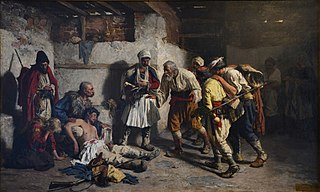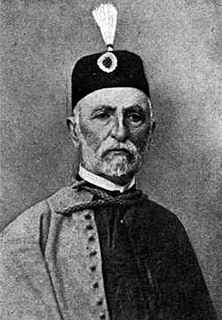
Serbian art refers to the visual arts of the Serbs and their nation-state Serbia. The medieval heritage includes Byzantine art, preserved in architecture, frescos and icons of the many Serbian Orthodox monasteries. In the Early modern period, Serbian visual arts began to be influenced by Western art, culminating in the Habsburg monarchy in the late 18th century. The beginning of modern Serbian art is placed in the 19th century. Many Serbian monuments and works of art have been lost forever due to various wars and peacetime marginalizations.
Zora Petrović was a Serbian painter. Her notable works can be seen in the Museum of Contemporary Art in Belgrade, and in Pavle Beljanski Memorial Collection in Novi Sad.

Janko Katić was a Serbian voivode and one of the organizers of the First Serbian Uprising (1804–1813). He participated in the uprising since day one, and was an important oborknez of the Šabac district, and was one of the most courageous commanders, so influential as a military and political leader that he was held by many as the second only to Karađorđe Petrović, the leader, in Šumadija.

Katarina Ivanović (1811–1882) was a Serbian painter from the Austrian Empire. She is regarded as the first Serbian female painter in modern art history.
Ljubomir "Ljuba" Ivanović was a Serbian painter, printmaker and draughtsman. He is considered one of the first Serbian impressionists, although he found his way of expression through graphic means.
Konda Bimbaša was a mercenary in Alija Gušanac's Dahije detachment in the Sanjak of Smederevo who switched sides to the Serb rebels during the First Serbian Uprising, proclaimed a hero for his efforts in the Siege of Belgrade (1806).

Seoba Srba is a set of four similar oil paintings by the Serbian artist Paja Jovanović that depict Serbs, led by Archbishop Arsenije III, fleeing Old Serbia during the Great Serb Migration of 1690–91. The first was commissioned in 1895 by Georgije Branković, the Patriarch of Karlovci, to be displayed at the following year's Budapest Millennium Exhibition. In the view of the Serbian clergy, it would serve to legitimize Serb claims to religious autonomy and partial self-administration in Austria-Hungary by upholding the contention that Serbs left their homeland at the behest of the Holy Roman Emperor to protect the Habsburg monarchy's borders.

The Takovo Uprising is the title of two nearly identical oil paintings by the Serbian realist Paja Jovanović. They depict rebel leader Miloš Obrenović inciting his countrymen against the Ottoman Empire and initiating the Second Serbian Uprising.

The Wounded Montenegrin is the title of four nearly identical compositions by the artist Paja Jovanović depicting a wounded youth surrounded by peasants in traditional clothing, likely during the Montenegrin–Ottoman War of 1876–78.

Stevan "Steva" Todorović was a Serbian painter and the founder of modern fencing and Sokol movement in Yugoslavia.

The siege of Belgrade was carried out by the Serbian rebels led by Karađorđe, seeking to overthrow the Ottoman government in the Sanjak of Smederevo, which was seated in the Belgrade Fortress. Following the decisive victories at Mišar and Deligrad (September), the Serbian rebels marched towards Belgrade.

The Proclamation of Dušan's Law Codex is the name given to each of seven versions of a composition painted by Paja Jovanović which depict Dušan the Mighty introducing Serbia's earliest surviving law codex to his subjects in Skopje in 1349. The Royal Serbian Government commissioned the first version for 30,000 dinars in 1899, intending for it to be displayed at the following year's Exposition Universelle in Paris.

Sowing and Harvesting and Market, popularly referred to as the Vršac triptych, is a three-panel oil painting by the Serbian realist Paja Jovanović. Painted around 1895, it shows the everyday interactions of the inhabitants of Vršac, a multi-ethnic and multi-religious town in the Banat region of Austria-Hungary of which Jovanović was a native. The painting was commissioned by the Vršac city council in 1895 for the following year's Budapest Millennium Exhibition.

Happy Brothers, Their Poor Mother! is an 1887 oil painting by the Serbian artist Uroš Predić. It shows four intoxicated youths walking through their village whilst the mother of one shouts her disapproval from the distance. The painting is said to have been inspired by a frequent sight in Predić's home village of Orlovat—that of drunken youths returning from the pub at dawn. Predić painted the composition hoping it would persuade the villagers to change their ways. He was disappointed that it not only failed to decrease the incidence of drunkenness in Orlovat, but was well received by the villagers themselves, who were happy merely to have been depicted.
Decorating of the Bride is an oil painting by the Serbian artist Paja Jovanović. It shows a young bride in traditional attire being prepared for her upcoming marriage by the female members of her household. It is one of two compositions Jovanović painted on the subject; the other is considered lost.

Vule Ilić , known as Vule Ilić Kolarac, was a Serbian military commander (vojvoda) who fought the Ottomans during the First Serbian Uprising. Vule Ilić Kolarac fought alongside Hajduk Stanoje Glavaš then under Grand Leader Karađorđe distinguishing himself at the Battle of Suvodol and at the Siege of Belgrade. During the uprising he was commander of the city of Smederevo the temporary capital of Serbia during that time.

Jovan Popović was a Serbian portrait painter.
Vasa Pomorišac was a Serbian artist and professor at the Academy of Applied Arts in Belgrade. He worked as a painter, stained glass window maker, etcher, printmaker and he was also an art critic. He is considered an expressionist painter in the same category as his contemporaries Mihajlo Petrov, Ivan Radović, Petar Dobrović, and Jovan Bijelić.
Danica Kojić was a Serbian architect and professional interior designer.
Branislav Đ. Kojić (1899-1986) was a Serbian architect, ruralist and painter.














